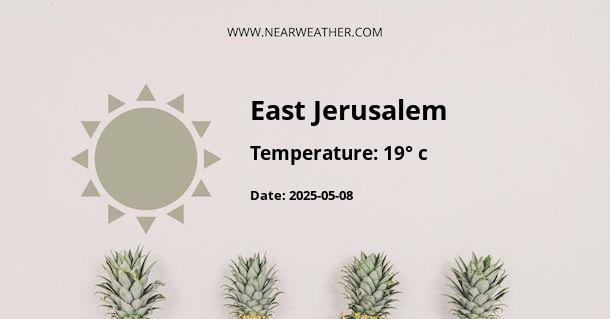Climate and Weather in East Jerusalem, PS
East Jerusalem, located in the West Bank, experiences a Mediterranean climate with hot, dry summers and cool, wet winters. The region is characterized by its diverse weather patterns and seasonal variations, making it an intriguing destination for travelers and weather enthusiasts alike.
Seasonal Climate
Understanding the seasonal climate variations in East Jerusalem is essential for planning a visit or gaining insight into the local weather patterns. The following table outlines the average temperature and precipitation for each season:
| Season | Average Temperature | Precipitation |
|---|---|---|
| Summer (June - August) | 25°C - 30°C | Low |
| Fall (September - November) | 15°C - 20°C | Moderate |
| Winter (December - February) | 5°C - 10°C | High |
| Spring (March - May) | 15°C - 20°C | Moderate |
As seen in the table, East Jerusalem experiences significant temperature variations throughout the year, with a notable increase in precipitation during the winter months.
Annual Weather Patterns
East Jerusalem's climate is influenced by its geographical location and proximity to the Mediterranean Sea. The region experiences distinct weather patterns throughout the year, as depicted in the following chart:

The chart illustrates the fluctuations in temperature and precipitation, highlighting the contrast between the dry, hot summers and the cool, wet winters. These annual weather patterns play a crucial role in shaping the local ecosystem and agricultural practices.
Extreme Weather Events
While East Jerusalem generally experiences a Mediterranean climate, the region is susceptible to occasional extreme weather events. These events can range from heavy thunderstorms and flash floods during the winter to heatwaves and dry spells in the height of summer.
"The topography of East Jerusalem contributes to localized weather phenomena, and residents are advised to stay informed about potential weather hazards."
It is important for residents and visitors to stay abreast of weather forecasts and advisories, particularly during the winter months when the risk of heavy precipitation is highest.
Impact on Tourism and Outdoor Activities
The unique climate of East Jerusalem offers diverse opportunities for outdoor enthusiasts and cultural explorers. From hiking in the cooler spring months to enjoying the warmth of summer festivals, the region's weather plays a pivotal role in shaping the tourism experience.
- Summer: Ideal for exploring historical sites and enjoying outdoor events due to the hot and dry weather.
- Fall: Pleasant temperatures and moderate precipitation provide a comfortable setting for outdoor excursions and nature walks.
- Winter: The cooler temperatures and higher rainfall present a different perspective of the region, with opportunities for experiencing local traditions and indoor attractions.
- Spring: The blooming landscape and mild weather create an inviting environment for outdoor activities and cultural immersions.
Understanding the seasonal climate variations can enhance the overall travel experience and ensure that visitors make the most of their time in East Jerusalem.
Conclusion
East Jerusalem's climate and weather patterns offer a captivating blend of Mediterranean influences, seasonal variations, and occasional extreme events. By delving into the region's climate, visitors and enthusiasts gain a deeper appreciation for its natural beauty and cultural significance. From the warmth of summer to the cool embrace of winter, East Jerusalem's weather enriches the tapestry of experiences available to all who venture there.
A - East Jerusalem's Latitude is 31.783360 & Longitude is 35.233879.
A - Weather in East Jerusalem is 9° today.
A - Climate Conditions in East Jerusalem shows scattered clouds today.
A - Humidity in East Jerusalem is 76% today.
A - Wind speed in East Jerusalem is 1.62 km/h, flowing at 297° wind direction. today.
